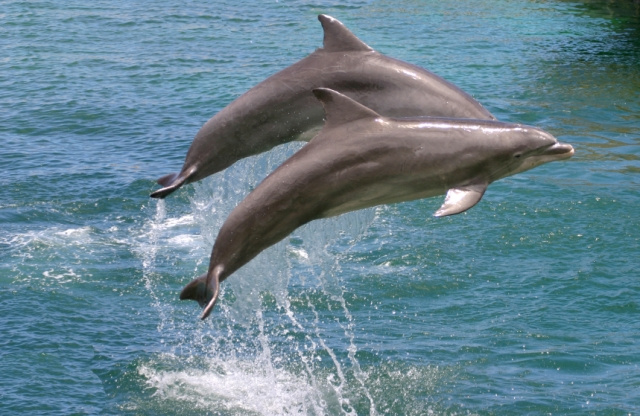Bottle-nosed Dolphin
Bottle-nosed Dolphin (Tursiops truncatus)Spanish name: Tursion, Bufeo

More about Bottle-nosed Dolphin
Habitat
The bottle-nosed dolphin lives in coastal waters or off oceanic islands.
Range
This dolphin is found worldwide in the tropics and subtropics. On the Pacific side of the Americas, it lives from southern California to Chile; on the Atlantic side, from Nova Scotia to Patagonia.
Physical Description
This graceful marine mammal is named for its distinctly shaped beak. It also has a characteristic, rounded forehead. Its coloration is dark blue to gray with a whitish belly and white on the tip of its snout. Its flippers are small with darkened edges, and it has a modest-sized dorsal fin. This dolphin has up to 52 teeth that are 1 cm long.
Interesting Biology
The Bottle-nosed Dolphin locates prey and other objects using high-frequency sound pulses to echolocate objects underwater. Bottle-nosed dolphins can speed 18 km/hour through the water, after prey or when swimming in the wake of boats, leaping and exhibiting their acrobatic feats. This is one of the most thoroughly studied small dolphins, and because it is, as some say, the smartest animal in the water, this species is most commonly used for trained purposes.
There are two categories of groups within this species: those that stay closer to shore and those that live by oceanic islands. Groups by the mainland tend to number around 10 individuals, but about 25 in the open ocean. Both kinds of groups have intricate social structures with a hierarchy based on size. Males fight aggressively over females during the mating season, but outside of reproductive competition these dolphins may hunt cooperatively for their meals. Schools of adults may stay together for 2-3 years, but groups also aggregate and split over time. Dolphins have a complicated communication system involving vocalizations, touching, and visual display. The ancient Greeks believed these dolphins would save people from drowning and protect them from sharks; it is true that bottle-nosed dolphins will help injured members of their group, and help them to the surface and support them so they can breathe.
Every 2-3 years a mother has a single calf after a gestation period of 12 months. Pups are born 1 m long; they are weaned at 18 months, but stay with the mother for 5 years. They become extremely attached, and even if the calf dies, the mother will stay next to the body for some time.
The bottle-nosed dolphin has adjusted some of its behaviors to human presence in its waters. For example, they may take fish from nets or follow fishing boats for the waste dumped overboard. This sea acrobat was vigorously hunted during the twentieth century; although today it is protected, in some coastal areas it is still caught for food or because the dolphin competes with humans for fish. Commercial tuna fishing poses the greatest threat to the bottle-nosed dolphin, because the dolphins are netted along with the tuna catches.
Diet
This species hunts shrimp, fish, and squid; each dolphin eats 6-7 kg of food each day.
Height/Weight
Adults are usually 1.75-3.6 m long and weight 150-650 kg; males are larger than females.
Brief Taxonomy
Order: Cetacea
Family: Delphinidae
Sources
Eisenberg, John. Mammals of the Neotropics, Vol. 1. The University of Chicago Press: Chicago, 1989.
Janzen, Daniel H. Costa Rican Natural History. Chicago: University of Chicago Press, 1983.
Saenz, Joel C., Grace Wong, and Eduardo Carrillo. Ballenas y delfines de America Central. Instituto Nacional de Biodiversidad. Costa Rica, 2004.
-Amy Strieter, Wildlife Writer
Bottle-nosed Dolphin Sightings
Similar Profiles
We believe travel is more than ticking destinations off a list – it’s about discovering new places deeply, feeling connected wherever you go, and knowing you have a trusted team behind you every step of the way.



